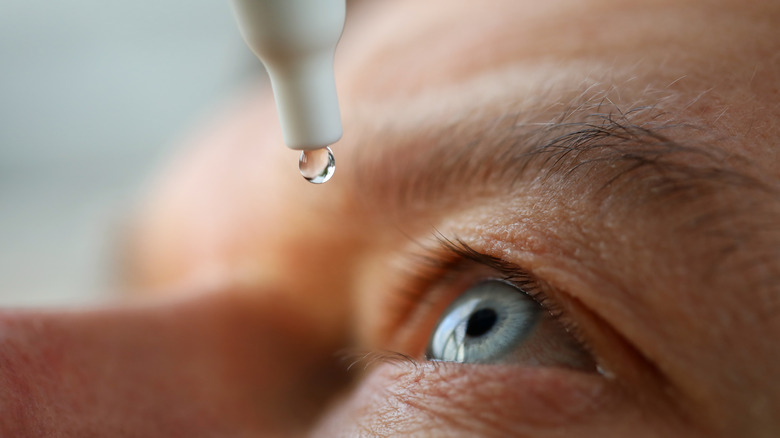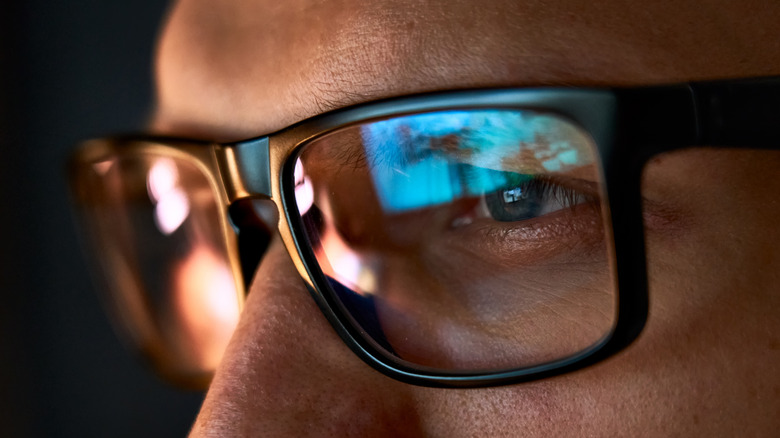Read This Before Using Eye-Whitening Drops
Eyes get tired, and if you have a lot of screentime, then you might realise how bothersome that can be. Besides screen time, there are other reasons for eyes to feel fatigued and turn red. There's lack of sleep, wearing contacts for a long time, and being exposed to dust. This redness is seen on the eye's sclera — a part that provides structure and support to the eyeball. A standard solution to this common problem is using eye-whitening drops.
Eye-whitening drops — also known as redness-relieving eye drops — are used to treat conditions such as glaucoma, allergies, post-surgery irritation, and inflammation (via Desert Health News). Tetrahydrozoline is a popular eye-whitening product, according to WebMD. It goes by the name Visine, which was its over-the-counter name. The product has been around for a while, and is known to help with eye redness. But now, several other over-the-counter eye-whitening drops come in different chemical combinations.
The usage of eye-whitening drops is common among people who regularly deal with eye redness. Lately, eye drops with a bluish-hue have become popular, leading to worries around their application. These eye drops stain the yellowness in the eye and give it a clearer look. But in actuality, you must be careful with them. According to Dr. Lin, M.D., these drops stain everything blue, and people who use them should proceed at their own risk. With so many eye drops available in pharmacies, it is important to know what you need — you want to be sure about what you're putting in your eyes.
Know this if you use eye-whitening drops regularly
It is essential to know how eye-whitening drops function to determine if those over-the-counter products are safe to use. According to Healthline, eye-whitening drops work in two ways. First, these drops constrict the blood vessels in the eye, thus decreasing the visibility of blood vessels in the sclera, leading to a reduction of redness in the eye. The second way is to provide moisture to the eye in the form of lubricants. The moisture helps reduce dryness and the apparent redness on the sclera.
But is it really a good idea to use eye-whitening drops regularly? According to WebMD, using eye-whitening drops daily may worsen the redness in the eyes. This rebound effect comes into action once the product wears off. In addition, a preservative used in eye-whitening drops called benzalkonium causes irritation and redness in the eye, making the condition worse.
It is essential to note that not all kinds of redness can be reduced using eye-whitening drops. Some eye redness results from infections or other health issues, and needs to be taken care of by a doctor. In that case, it is best to consult a doctor before using self-prescribed eye drops.
Be wary of the side effects of eye-whitening drops
Another reason why people must be wary of the eye drops they use is the associated side effects. As per WebMD, some of the most common side effects include a burning sensation in your eyes, dry or itchy eyes, blurry vision, seeing double, night blindness, headache, redness, swelling, and tunnel vision.
But what about self-prescription? Since these drops are readily available for purchase, it is easy to misuse them and ignore the warnings on the label. One of the common mistakes that people make is not seeing an ophthalmologist, and relying too much on the eye-whitening drop for relief. Healthline suggests that eye drops should not be used for more than 72 hours. If the redness remains longer than three days, you should immediately speak to your doctor.
Most eye-whitening drops are readily available, but you should still check the product labels and ensure that your product is FDA-approved. Doing research around these products and reading customer reviews also helps.



